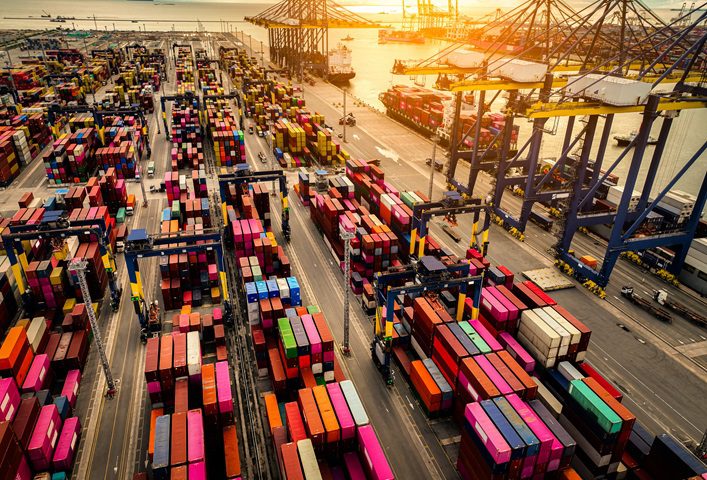02.09.2025
Polish seaports in the first half of 2025
Polish seaports ended the first half of 2025 with 68.46 million tonnes of transshipments, an increase of 1.05% year-on-year, according to the latest Port Monitor report prepared by the consulting company Actia Forum.

The Port of Gdansk remains the leader in terms of volume, handling 38.25 million tonnes of cargo.
Individual port results
In January-June 2025, the Port of Gdansk handled the largest volume – 38.25 million tonnes (+0.36% y/y). Second place was taken by the Szczecin-Świnoujście port complex with a result of 17.15 million tonnes (+7.69% y/y), and third place was taken by the Port of Gdynia – 13.06 million tonnes, recording a decrease of 4.78% y/y.
The decline in Gdynia’s result, was mainly related to the reduction in grain exports. On the scale of the entire market, the transshipment of cereals decreased by 33.09 percent, to about 4 million tons.
Exports of processed goods are growing in strength
The strongest trend in the analysed period was the 9.6 per cent increase in general cargo transshipment, to the level of almost 30 million tonnes. This is a direct signal that Polish exports are moving towards goods with higher added value: machinery, industrial components, metal products, household appliances and chemical products.
- The Port of Gdansk increased the volume of general cargo by 12.23% ( an increase of over 1.4 million tonnes),
- Port of Gdynia – an increase of 5.53 percent,
- Szczecin-Świnoujście – up by 5.53 pecent.
These results are reflected in container statistics – transshipments at container terminals increased by a total of 20.72 percent, which strengthens the export logistics of companies operating on EU and global markets.
Containers and ro-ro
Polish container terminals handled a total of 1.88 million TEU. The highest number was recorded at the Port of Gdansk – nearly 1.3 million TEU (+20.5%), which was the result of, among other things, the launch of the T3 terminal at the Baltic Hub and the new services of the Gemini and Premier Alliance shipping.
In Gdynia, container handling increased by 19.18 percent (536.2 thousand TEU), and in Szczecin-Świnoujście by 46.11 percent (over 50 thousand TEU), thanks to the Eimskip line.
In the ro-ro segment, 35,600 freight units were handled (+7.34% y/y). The highest number was in Szczecin-Świnoujście – 238,380 units (+8.09 per cent). In Gdynia, 106,100 units were handled (+8.48 per cent), and in Gdańsk a decrease of 17.6 per cent was recorded (9152 units).
Structure of transshipments – decreases and increases
A decrease in turnover was recorded in four cargo groups:
- cereals: -33.09 percent,
- coal and coke: -8.22 %,
- wood: -0.09 percent,
- fuel: -1.5 percent
Increases were recorded in among other things, the case of:
- metal ore: +45.66 per cent,
- general cargo: +9.6 percent,
- other mass cargo: +16.42 per cent.
Coal and fuels
In the first half of 2025, 4.08 million tons of coal were transshipped – 365,000 tons less than a year earlier. The volume is close to the level before the outbreak of the war in Ukraine, and the downward trend has been maintained since the record years of 2022-2023.
Total fuel transshipments amounted to 25.09 million tonnes. The Port of Gdansk handled the most – 19.2 million tonnes (a decrease of 4.75 per cent). In Gdynia, the decrease was greater – by 19.84 percent, to 1.27 million tons. The only port with an increase was Szczecin-Świnoujście – 4.6 million tonnes (+23.61 per cent), mainly due to a record number of LNG deliveries – the terminal in Świnoujście received 40 tankers with gas, the highest number in its history in half-year terms.
Source: Gospodarka Morska, „Podsumowanie wyników polskich portów morskich w pierwszej połowie 2025 roku”
- Everything
- News (303)
- Events (173)
- Get Support (83)
-

BUS-CENTER TOMASZ GAD
Automotive industryShow allShow more Show lessBus-Center is a Polish manufacturer operating since 2002, specializing in premium minibus conversions on Mercedes-Benz Sprinter and Iveco Daily base vehicle. We deliver EU-homologated coach, shuttle, school and VIP configurations, offering high-quality craftsmanship, durability and tailored solutions for transport operators across Europe.

LUBFARM SPÓŁKA AKCYJNA
Show more Show lessLubfarm is a prominent pharmaceutical wholesaler based in Lublin, Poland. With over 30 years of experience, the company distributes a wide range of medicines, medical devices, and supplements to pharmacies and hospitals nationwide. Lubfarm distinguishes itself through modern logistics, high service standards, and a vast product portfolio. As a trusted partner in the healthcare sector, they ensure reliable and timely supplies, playing a vital role in the Polish pharmaceutical market.

Opti-Front Michał Radoń
Show more Show lessOPTI-FRONT is a European manufacturer of advanced furniture fronts and bent elements made of MDF. We specialize in precision reeded (fluted) fronts. We operate in Poland, combining CNC technology with craftsmanship. We are a reliable export partner for architects and premium manufacturers, guaranteeing stability and high quality. We serve markets including Germany, Slovakia, and the UK.

WOBA SPÓŁKA Z OGRANICZONĄ ODPOWIEDZIALNOŚCIĄ SPÓŁKA KOMANDYTOWA
Other goodsShow allShow more Show lessWOBA is a company which was established in 1999 in Łódź. The main focus of our business activities is production and sale of items such as: scourers, cloths, traditional mops, flat mops, and bath sponges. We operate both on the domestic and foreign markets. Thanks to their excellent quality and affordable price, our products are highly regarded and are enjoying growing interest abroad.
-
 Event
EventSolar Energy Expo 2026
Solar Energy Expo is Poland’s largest renewable energy industry trade fair
 Event
EventPolish Logistics Day
The Embassy of the Republic of Poland in Prague cordially invites you to participate in the “Polish …
-
 Institution
InstitutionThe Investor Tax Service Center
The Investor Tax Service Center is a unit operating within the Ministry of Finance
 Institution
InstitutionPolish Investment and Trade Agency (PAIH)
The Polish Investment and Trade Agency (PAIH) is the partner of first-resort for entrepreneurs when …
The Export Promotion Portal uses cookies to make it easier for users to use the website and for statistical purposes. If you do not block these files, you agree to their use and saving in the memory of your computer or other device. Remember that you can change your browser settings to block the storage of cookies. More information can be found in Privacy Policy and Terms and conditions.







